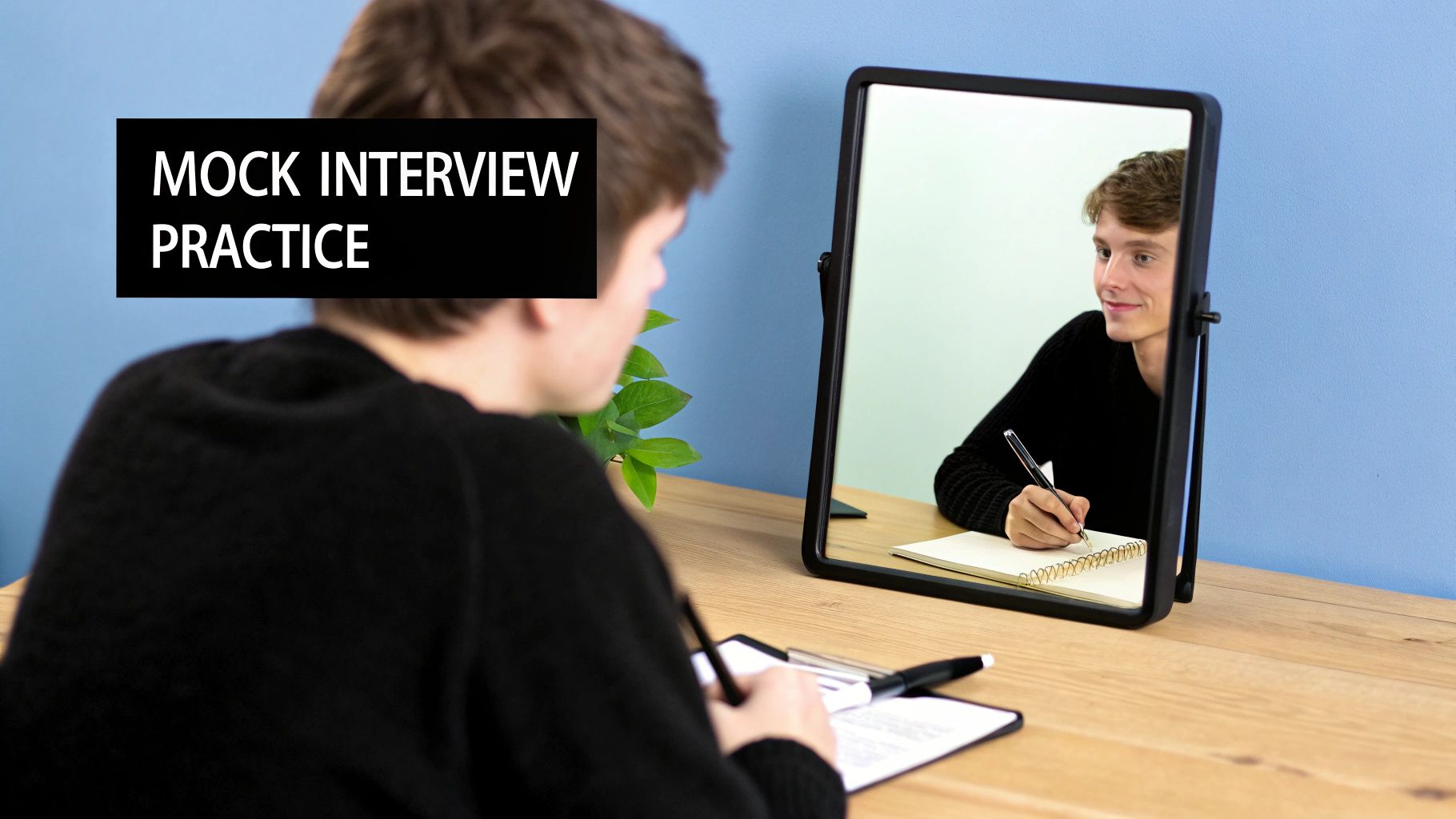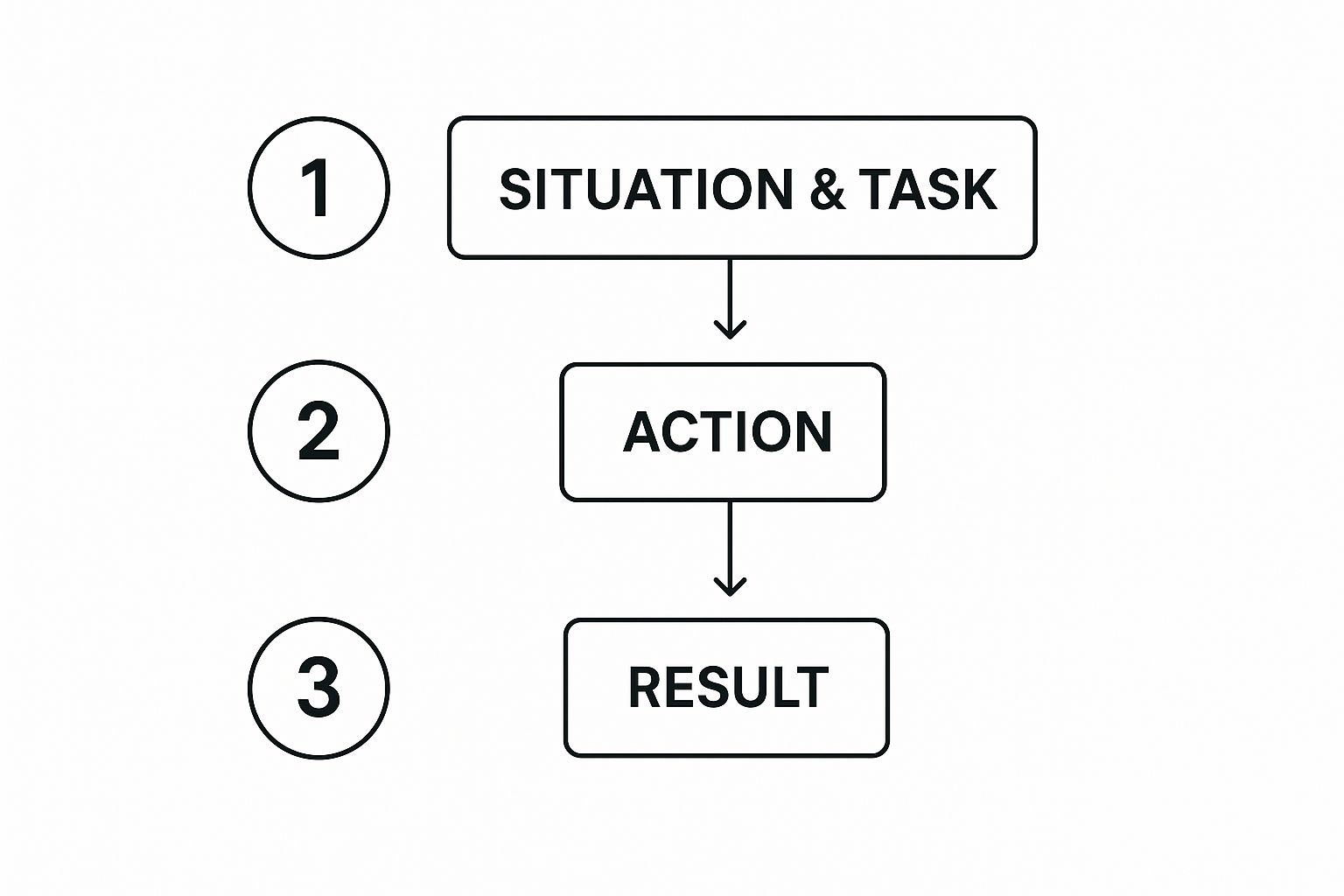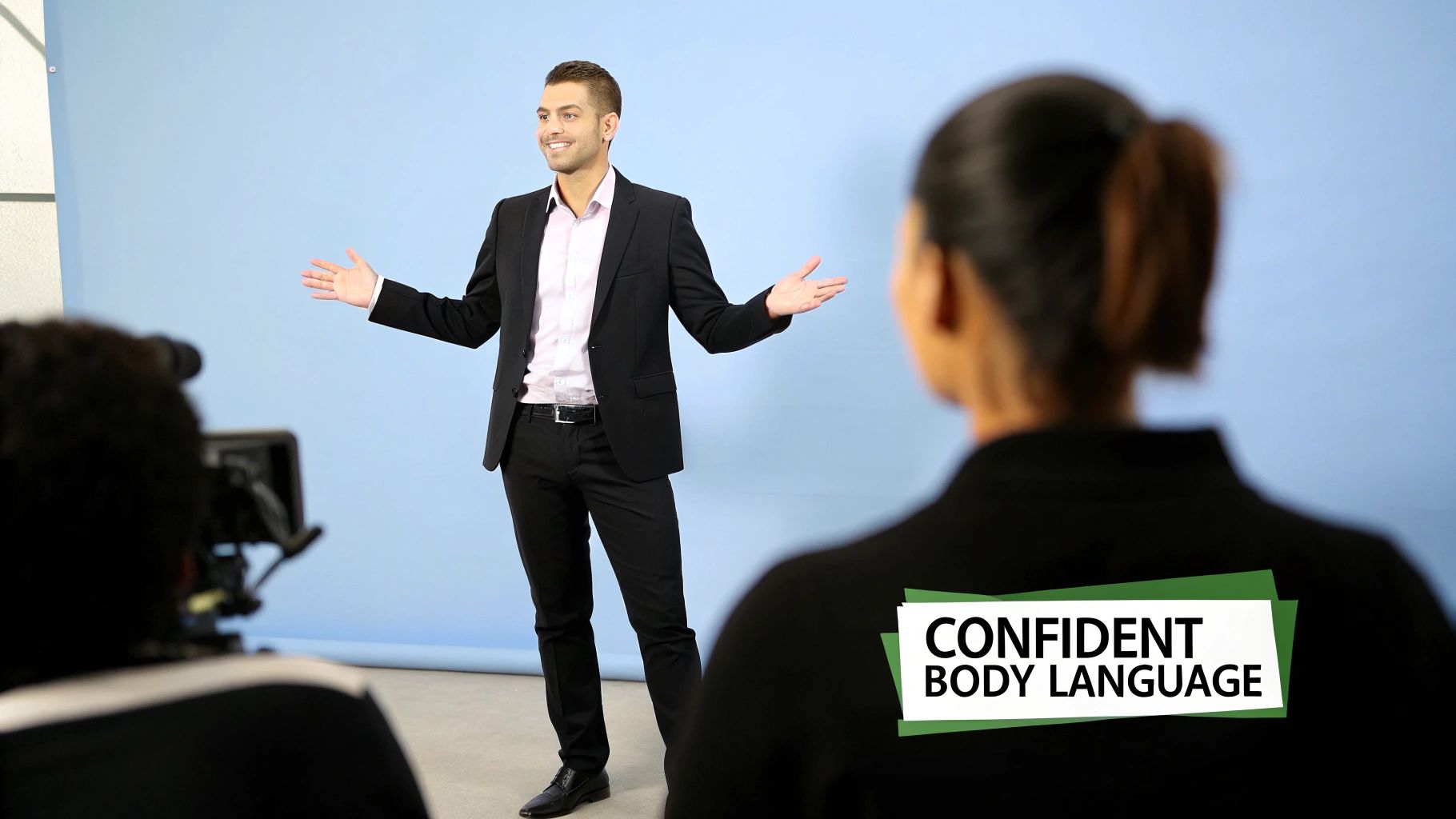How to Answer Interview Questions Confidently: Tips & Strategies

Nailing your interview answers really boils down to two things: solid preparation and a clear, structured way of telling your stories. It’s less about memorizing lines and more about building a mental library of your accomplishments and knowing how to pull from it.
When you master this, you shift the entire dynamic. The interview stops feeling like an interrogation and starts feeling like a genuine conversation where you can show your true value.
Why Confidence Is Your Secret Weapon in an Interview
Confidence isn't just about feeling good about yourself—it's a powerful signal to the hiring manager. When you speak with conviction, you’re showing them you're capable, reliable, and ready to hit the ground running. It’s your non-verbal way of demonstrating composure and problem-solving skills, right there in the moment.
Your resume got you the meeting, but how you deliver your answers is what seals the deal. It’s what turns a basic Q&A into a compelling pitch for why you're the right person for the job.
Seeing It from the Recruiter's Side
Recruiters are trained to see confidence as a proxy for competence. If a candidate is hesitant, fumbles for words, or avoids eye contact, it can easily be interpreted as a lack of conviction in their own skills—no matter how impressive their resume is.
This is a huge deal in a crowded job market. Consider this: job interview statistics show that a staggering 40% of recruiters won't move forward with a candidate who lacks confidence. With an average of 118 people applying for a single role and only 20% even getting an interview, projecting self-assurance isn't just a nice-to-have; it's what separates you from the pack.
To illustrate just how much your delivery matters, let's look at how the same answer can land completely differently based on the confidence behind it.
The Confidence-Competence Connection
This table shows how a confident delivery can completely change how your answers are perceived.
| Behavior | Low-Confidence Delivery | High-Confidence Delivery | Recruiter's Perception |
|---|---|---|---|
| Vocal Tone | Mumbles, speaks too quietly, uses upward inflection | Clear, steady, and audible voice | Sounds knowledgeable and credible |
| Pacing | Rushes through answers or has long, awkward pauses | Speaks at a measured, conversational pace | Appears calm and in control |
| Body Language | Slouches, avoids eye contact, fidgets nervously | Sits upright, makes steady eye contact, uses natural gestures | Projects professionalism and engagement |
| Language | Uses filler words ("um," "like") and hesitant phrasing | Speaks directly and concisely, using "I" statements | Comes across as decisive and self-aware |
As you can see, the exact same qualifications can be perceived as either weak or strong based entirely on how they are presented. High-confidence delivery makes your skills seem more valuable and reliable.
A confident answer shows you’ve reflected on your experiences and understand their value. It’s not about arrogance; it’s about clarity and ownership of your professional story.
At the end of the day, interviewers are trying to find someone who can step into the role and start making a difference. Your confidence is what assures them that you’re that person.
For a deeper look into every stage of the hiring process, this comprehensive interview guide is an excellent resource for mastering the entire journey.
Build Your Story Bank Before the Interview

Real confidence isn’t something you can fake on the spot. It’s what happens when you’ve done the work beforehand. The secret to walking into an interview and nailing the questions is having a well-stocked "story bank"—a collection of your best career moments ready to share.
This isn't about memorizing lines like an actor. It’s about knowing your own professional story so well that you can adapt it to any question they throw at you.
Instead of just glancing over your resume, you need to mine it for gold. Look at each bullet point and ask yourself: What’s the real story here? What was the challenge I faced? What, specifically, did I do? And what was the measurable result of my actions?
This simple exercise is what turns a flat statement like "I'm a good team player" into a compelling story about how you navigated a tricky team conflict to deliver a project ahead of schedule. That’s what interviewers remember.
Deconstruct the Job Description
Think of the job description as your cheat sheet. Don't just skim it—dissect it. I always tell people to print it out and get a highlighter. Mark up every key responsibility, every required skill, and any mention of the company's current challenges or goals.
Those highlighted words are the exact themes your stories need to hit. If "cross-functional collaboration" is mentioned five times, you better believe you need a story about working with other departments. If they’re focused on "data-driven decision-making," you’ll want a powerful example of how you used analytics to pivot a strategy for the better.
When you tailor your stories this way, you’re sending a clear signal: you haven't just applied for a job, you've prepared for this job. That level of targeted preparation shows both competence and genuine interest.
True confidence in an interview comes from knowing you have a relevant, proven example for whatever the hiring manager asks. It removes the fear of being caught off guard.
Knowing your value and being able to prove it makes all the difference. While 76% of workers feel confident in their skills, only 62% are actually satisfied in their jobs. This often comes down to a mismatch between what they can do and what the role demands. By building a story bank, you can clearly articulate that alignment from day one. You can read more about this in the global talent barometer and worker confidence report.
Catalog Your Career Wins
Now, you need to get organized. Under pressure, your brain isn't going to magically recall the perfect example. You need a system. A simple spreadsheet or a document works perfectly for this.
Create columns to structure your stories. Think: Situation, Task, Action, and Result. This is a classic framework for a reason—it works.
To get you started, think about stories that fit these common themes:
- Problem-Solving: A time you spotted a tough problem and created a solution that actually worked.
- Teamwork and Leadership: An instance where you stepped up to lead a project, mentor a junior colleague, or mediate a team dispute.
- Learning from Failure: A project that went sideways and, more importantly, what you took away from the experience.
- Taking Initiative: Something you built, improved, or fixed without anyone asking you to.
This story bank becomes your personal library of proof. The next time an interviewer says, "Tell me about a time you showed initiative," you won't freeze up. You'll just flip to the right page in your mental catalog, pull out a polished example, and answer with total confidence.
Structure Your Answers for Maximum Impact
Having your best career stories ready is only half the battle. If you can’t deliver them in a way that’s clear, compelling, and easy to follow, your message gets lost.
The best answers have a clean architecture—a beginning, a middle, and an end. Without a solid structure, even your most impressive achievements can turn into a rambling narrative that leaves the interviewer confused. This is where a good storytelling framework comes in. It’s the secret weapon that stops you from going off on tangents and makes sure you hit all the key points hiring managers are listening for.
Tell a Compelling Story with the STAR Method
One of the most powerful frameworks out there is the STAR method. It's a simple, memorable way to structure your answers, especially for those behavioral questions that start with "Tell me about a time when..."
STAR breaks your story down into four clear parts:
- Situation: Briefly set the scene and provide context. What was the challenge?
- Task: What was your specific goal or responsibility in that situation?
- Action: What specific steps did you personally take to handle it? This is the core of your story.
- Result: What was the outcome? This is where you shine by sharing measurable results.
Let's walk through a real-world example. Imagine the interviewer asks, "Tell me about a time you handled a tight deadline."
A weak, forgettable answer sounds like this: "Oh yeah, my last project was really rushed. We all just worked late and got it done." It’s vague and tells the interviewer almost nothing about what you did.
Now, let's reframe that using the STAR method:
(S) Situation: "In my last role, our biggest client suddenly moved up a project deadline by two full weeks. This created a major time crunch for our four-person team and put the entire launch at risk."
(T) Task: "My responsibility was to re-evaluate the project scope, map out a new, compressed timeline, and get immediate buy-in from both our team and the client."
(A) Action: "First, I scheduled an emergency meeting to identify the absolute 'must-have' features for the new launch date. Using that info, I built a revised project plan in Asana, breaking everything down into daily tasks. I then presented this new roadmap to the client, clearly explained the trade-offs, and got their approval on the revised scope."
(R) Result: "By quickly reorganizing our efforts, we successfully delivered all the critical features on the new deadline. The client was so impressed with our agility and communication that they extended our contract by another six months."
See the difference? This answer is packed with evidence. It demonstrates ownership, problem-solving skills, and a direct, positive business outcome.

The STAR method creates a logical flow from context to outcome, making your contributions easy to understand and remember. Getting comfortable with this framework is one of the best ways to walk into any interview feeling prepared and confident.
Develop a Natural Flow Through Practice

Knowing your career stories is one thing, but delivering them smoothly under pressure is a completely different skill. The point of practicing isn't to memorize a script—that's a surefire way to sound robotic. Instead, you're building muscle memory. You're getting so comfortable telling your stories that they come out naturally, even with a case of the nerves.
So, how do you do that? Start by recording yourself.
Seriously. Prop up your phone or use your webcam and answer common interview questions out loud. Watching yourself on playback can be a real eye-opener. You’ll immediately catch all the "ums," "ahs," and other little verbal tics you never knew you had.
This is one of the fastest ways to get better because it forces you to see yourself from the interviewer's perspective. You'll pinpoint exactly where your energy dips or where your explanation starts to get a little muddy.
Go Beyond Solo Practice
Once you've spent some time refining your answers on your own, it's time to bring in another person. Running a mock interview with a friend, mentor, or even a career coach gives you that real-time feedback you just can't get by yourself.
Pick someone you trust to be honest—you don't need a cheerleader right now, you need someone who will give you constructive criticism. Hand them the job description and a list of typical questions. This adds a layer of unpredictability that mimics a real interview and tests how well you can think on your feet.
This kind of practice is what turns your stiff, prepared bullet points into flexible, engaging stories. Here's what you'll master:
- Pacing: You’ll learn to slow down and speak at a conversational speed, not rush through your answers because you're nervous.
- Clarity: It forces you to ditch the jargon and get straight to the point, making your answers much more powerful.
- Authenticity: The more you practice, the more you come through, which helps you build a genuine connection with the interviewer.
The goal of practice isn't perfection, it's familiarity. When you're familiar with your own stories, you can deliver them with conviction instead of anxiety.
Ultimately, all this prep work builds a deep, unshakable confidence that's impossible to fake. When you walk into that interview, you won't be struggling to remember memorized lines. You'll be ready to have a conversation, pulling from a well-rehearsed collection of stories that prove you're the right person for the job.
Project Confidence with Body Language and Tone

It’s a classic saying for a reason: it’s not just what you say, but how you say it. The words you choose are obviously important, but your non-verbal cues can either amplify your message or completely sabotage it. This is where mastering your body language becomes a secret weapon.
Think about the message your physical presence sends before you even utter a word. Sitting up straight, leaning in just a bit, and keeping an open posture shows you’re engaged and sure of yourself. On the flip side, slouching or crossing your arms can come across as boredom or defensiveness, even if you don't mean it.
Mastering Your Non-Verbal Cues
Whether you’re in the room or on a video call, a few small tweaks to your delivery can make a world of difference.
- Make Eye Contact: Try to maintain a steady, natural gaze. If you’re on a video call, this is your cue to look right at the camera lens when you're talking. It’s the digital equivalent of looking someone in the eye, and it creates a much stronger connection.
- Use Your Hands: Don't be afraid to use hand gestures to emphasize a point. It adds energy to your answers and shows you’re genuinely passionate about what you’re discussing.
- Vary Your Tone: A monotone voice can make even the most exciting accomplishment sound flat. Vary your pitch and pace to keep the interviewer engaged and to convey your own enthusiasm.
Your body language and tone of voice are the packaging for your skills. When they align with your words, they create a cohesive, powerful impression of a candidate who is not just qualified but also ready to lead.
These tips aren't just for interviews; they're foundational communication skills. You can find more strategies to improve your presentation skills that translate perfectly to making a great impression in your next interview.
Frequently Asked Questions About Interview Confidence
Even after all the prep work, you’ll run into specific moments that can really shake your confidence. Let's dig into a couple of the most common "what if" scenarios I see trip people up.
How Do I Avoid Sounding Arrogant?
This is a big one. Nobody wants to come across as a braggart. The key difference between confidence and arrogance really boils down to evidence and humility. Confidence is about showing what you’ve done; arrogance is just making a lot of noise about how great you are.
Instead of a blanket statement like, "I'm the best project manager you'll find," you need to ground your claims in reality. Tell a story. Try something like, "On my last project, we were falling behind. I introduced a new tracking system that boosted our team's efficiency by 15%, and we hit our deadline." See the difference? You're letting the results speak for themselves.
And here’s another pro tip: always share the credit. Talking about what "we" accomplished shows you're a team player, not someone who thinks they're a one-person show.
Confidence is backed by facts and data. Arrogance relies on ego and unsupported claims. Stick to your accomplishments, and you'll always land on the right side of the line.
What If My Mind Goes Blank?
First off, take a breath. It happens to the best of us, and any decent interviewer has seen it before. The absolute worst thing you can do is panic and start filling the silence with nonsense. Instead, own the moment and take a deliberate pause.
It's completely fine to say something like, "That's a great question. Let me take a second to think of the best example." This little phrase is a lifesaver. It buys you precious time and makes you look thoughtful, not flustered.
If you’re truly stuck and don't have a direct answer, don't try to fake it. Be honest, but then pivot to a related strength. For instance: "I haven't worked with that specific software, but I'm a really fast learner. Last quarter, I had to pick up a new analytics platform and was building custom reports for my team within a week." This move cleverly turns a gap in your experience into a showcase of your adaptability.
For more deep dives into crafting these kinds of compelling career stories, you can find a ton of great material on the ParakeetAI blog.
Ready to walk into your next interview with unshakable confidence? ParakeetAI is your personal interview assistant, providing real-time, AI-powered answer suggestions tailored to your resume. Stop guessing and start impressing. Learn more at ParakeetAI.




